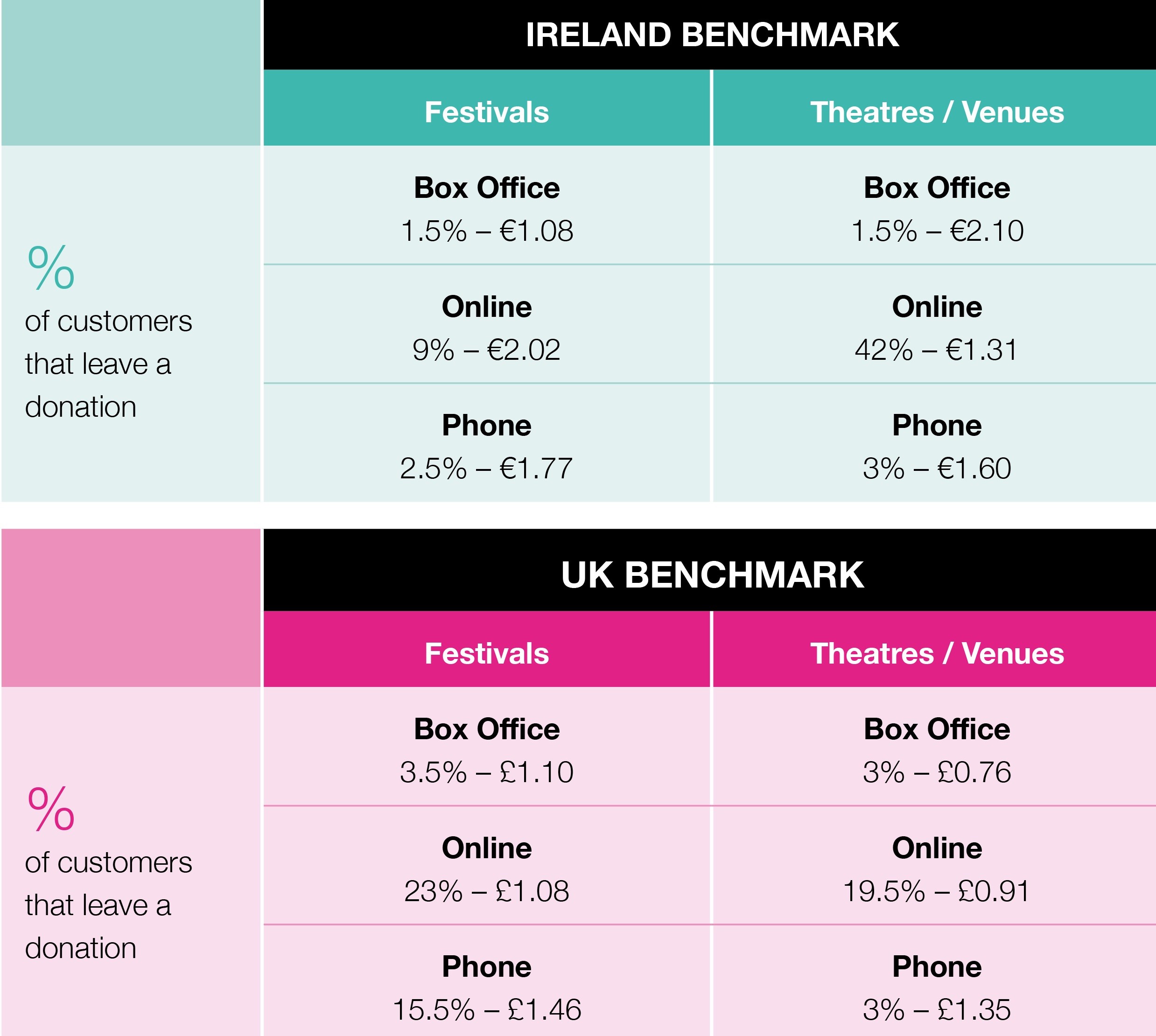Fundraising Playbook: Easy Steps to Kickstart Your Arts Fundraising Strategy

The playbooks use benchmarks or Ticketsolve user averages throughout, which gives you an idea of where you and your organisation compare to other Ticketsolve users. This is a great concrete way for you to create your own roadmap for success on any given project.
Fundraising Playbook: First in the Series
To date, we have only shared these playbooks with our users, however we wanted to share some of them with a wider audiences, as we found that Ticketsolve users find them extremely useful. Below is our Fundraising Playbook, which will give you benchmarks and a deeper insight into how to jumpstart your own fundraising campaigns. Right at the end, you will also be able to download the playbook so that you can keep it as a quick how to guide. We hope you enjoy it and please let us know what you think.
Getting Arts Fundraising Right For Your Organisation
We all know how important fundraising is in the arts. With budgets getting tighter and funding drying up, fundraising has become even more crucial to arts revenues. However, it can be difficult to know if your fundraising strategies are on the right track. Is there a better way of raising funds? What are best practices in fundraising inside and outside the arts? How do we increase per patron donations? All valid questions that are hard to answer, especially if you are only looking at your own data. Enter Ticketsolve fundraising benchmarks. We have utilised aggregate data from over 250 organisations in the Ticketsolve community, to provide you with a benchmark of where others are with regards to fundraising, along with insights on how to improve fundraising efficiency and effectiveness in the arts.
Benchmark

Turn the Dial to Kickstart Fundraising
Keep in mind, the above are averages. Some organisations are making significant strides in their fundraising and donations activities, while others have identified clear areas for improvement. So what exactly are the successful organisations doing? What strategies are they using to improve their overall donation percentage, and the amount given per donation? We spoke to some organisations who do particularly well with fundraising and donations, and shared their ideas below, along with some ideas of our own. We haven't gone into too much detail below, as you can download the playbook yourself to see all of the hints and tips.
Use the Right Hook
Engaging audiences is job one of any donations strategy. But if you can't get your customers' attention right away they may never even get a chance to fully engage with you. The right hook, an attention grabbing headline or title can be all it takes to capture your audience's interest. Consider changing the title of the support us page to make a bigger impact.
Establish an Emotional Connection
You've hooked them, so now is the time to engage them. Your copy needs to be targeted, engaging, lively, impactful, and interesting to read. Think about using real stories or people in your copy. Using the correct narrative that really speaks to your audiences is the key ingredient to encourage patrons to leave a donation. Be clear on why you need their donation now, what the donation is for and how their generosity will help.
Nudge Tactics
Another option is to try a “nudge” tactic. For example, people are often influenced by their peers, a simple message of: “Did you know that 40% of all our theatre attendees left a donation,” is a little nudge to show customers what their peers are doing, and encourages them to do the same.
A Picture Paints a Thousand Words
Images, videos and the like are another great way to capture people's imagination and attention. The Greenbelt Festival incorporate a fantastic image that quickly explains their mission. The image clearly shows how working together will help the festival grow and thrive. Check out Greenbelt's Support Page for a great example of image use on a fundraising page.

Donation Prompt
Adding an auto donation to the cart is bad practice, and likely to upset customers. In addition, donation legislation is a definitely fuzzy, so rather than worry about opt in or opt out for donations, it is better to provide a donation prompt for customers. Prompting the donation puts the choice of donating into your customer’s hands.
Follow Up Email
Our Mailchimp integration allows you to create automated emails as soon as a customer leaves a donation. It is really important to do this immediately, as you want to thank those customers for leaving a donation. The thank you email, is a great way to continue building customer loyalty. As we said, we have only included a few of our ideas above, please feel free to download the playbook by clicking below. Over the coming weeks and months, we will be releasing more of these playbooks so keep an eye out for them.
Categories
Recent posts
Archive
- December 2025 (2)
- November 2025 (1)
- October 2025 (3)
- September 2025 (1)
- August 2025 (3)
- July 2025 (3)
- June 2025 (3)
- May 2025 (4)
- April 2025 (5)
- March 2025 (5)
- February 2025 (4)
- January 2025 (4)
- December 2024 (3)
- November 2024 (5)
- October 2024 (4)
- September 2024 (7)
- August 2024 (5)
- July 2024 (3)
- June 2024 (3)
- May 2024 (3)
- April 2024 (3)
- March 2024 (4)
- February 2024 (5)
- January 2024 (3)
- December 2023 (3)
- November 2023 (4)
- October 2023 (4)
- September 2023 (5)
- August 2023 (3)
- July 2023 (4)
- June 2023 (4)
- May 2023 (5)
- April 2023 (4)
- March 2023 (4)
- February 2023 (5)
- January 2023 (4)
- December 2022 (4)
- November 2022 (3)
- October 2022 (4)
- September 2022 (5)
- August 2022 (2)
- July 2022 (4)
- June 2022 (5)
- May 2022 (4)
- April 2022 (5)
- March 2022 (3)
- February 2022 (4)
- January 2022 (4)
- December 2021 (2)
- November 2021 (3)
- October 2021 (5)
- September 2021 (4)
- August 2021 (4)
- July 2021 (3)
- June 2021 (4)
- May 2021 (2)
- April 2021 (4)
- March 2021 (5)
- February 2021 (4)
- January 2021 (5)
- December 2020 (4)
- November 2020 (4)
- October 2020 (5)
- September 2020 (5)
- August 2020 (4)
- July 2020 (7)
- June 2020 (5)
- May 2020 (5)
- April 2020 (5)
- March 2020 (8)
- February 2020 (4)
- January 2020 (5)
- December 2019 (3)
- November 2019 (5)
- October 2019 (4)
- September 2019 (4)
- August 2019 (5)
- July 2019 (4)
- June 2019 (4)
- May 2019 (5)
- April 2019 (4)
- March 2019 (4)
- February 2019 (3)
- January 2019 (5)
- December 2018 (4)
- November 2018 (8)
- October 2018 (2)
- September 2018 (3)
- August 2018 (5)
- July 2018 (4)
- June 2018 (4)
- May 2018 (1)
- April 2018 (1)
- March 2018 (3)
- February 2018 (2)
- December 2017 (2)
- November 2017 (3)
- October 2017 (4)
- September 2017 (2)
- August 2017 (1)
- July 2017 (5)
- June 2017 (3)
- May 2017 (2)
- April 2017 (3)
- March 2017 (2)
- February 2017 (3)
- January 2017 (3)
- December 2016 (4)
- November 2016 (1)
- September 2016 (1)
- July 2016 (3)
- June 2016 (1)
- May 2016 (2)
- April 2016 (2)
- February 2016 (1)
- January 2016 (3)
- December 2015 (2)
- September 2015 (1)
- August 2015 (2)
- July 2015 (1)
- June 2015 (2)
- May 2015 (2)
- April 2015 (5)
- March 2015 (2)
- February 2015 (2)
- January 2015 (4)
- December 2014 (3)
- November 2014 (3)
- October 2014 (2)
- September 2014 (3)
- August 2014 (3)
- July 2014 (3)
- June 2014 (7)
- May 2014 (6)
- April 2014 (3)
- March 2014 (2)
- February 2014 (1)
- January 2014 (3)
- December 2013 (1)
- August 2013 (1)
- June 2013 (1)
- April 2013 (1)
Sign up for regular updates


